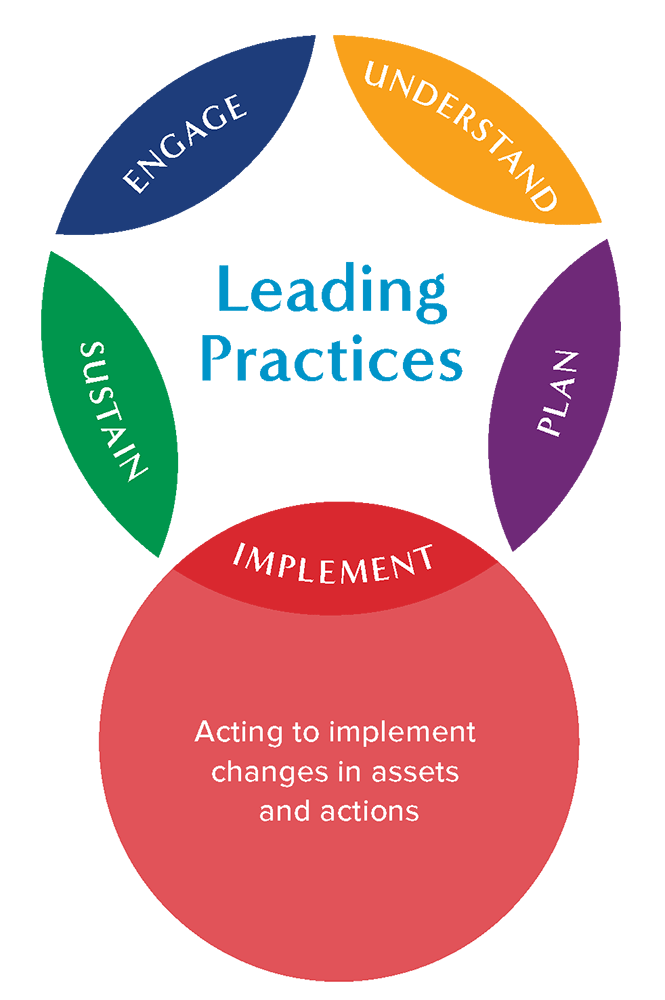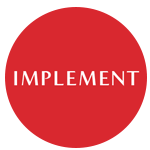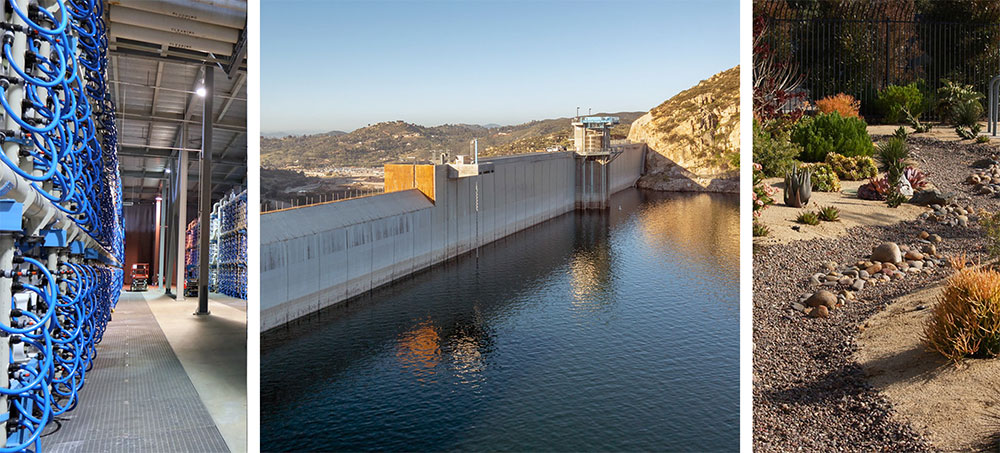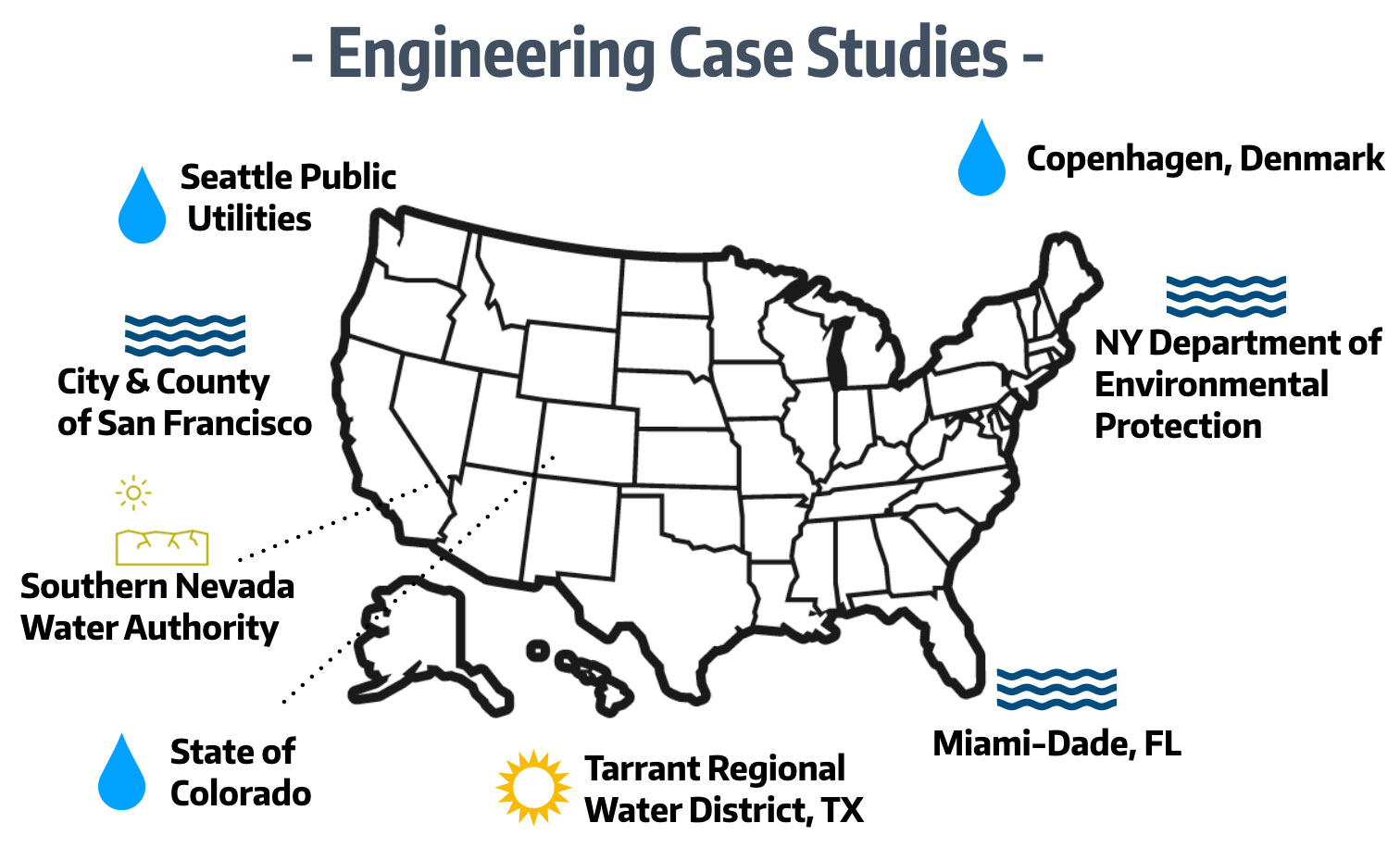IMPLEMENT
The goal of climate adaptation is to change an organization's actions and assets, thus improving its ability to adjust appropriately to future change. There are many ways to implement effective actions, though there are strategic approaches WUCA members have found particularly useful.
Leading practices in the IMPLEMENT action area, introduced below, illustrate ways WUCA members have taken action on climate adaptation.
In the IMPLEMENT action area, leading practices include:
- Be prepared to act when opportunities arise
- Find co-benefits and no- and low-regret adaptation strategies
- Recognize some adaptations can be employed quickly
- Recognize smaller changes can lead to bigger ones
- Focus on your organization's core responsibilities first
- Enact incentives or policies that change behavior
- Enact changes in infrastructure and operations



Be prepared to act when opportunities arise
Being able to act often requires having information, ideas, and strategies ready for when the time is right to introduce them. When possible, work with others in your organization to identify when opportunities for creating change might arise and what information would be most useful in those situations. Opportunities might include pointing to an event (e.g., water shortage) to emphasize what likely future conditions will be or making strategic suggestions when planning documents are revised.
Example: Post-hurricane actions
Prior to Superstorm Sandy, New York City was studying the potential impacts of climate change on its stormwater and wastewater systems, beginning with one of its 14 wastewater facilities. When Sandy struck, the City was able to quickly build upon the analysis and organizational capacity established by its initial study to develop a citywide plan that assessed all 14 facilities. The resulting NYC Wastewater Resiliency Plan helped the City receive over $160 million in federal funding to implement mitigation measures to protect against future storms.
Example: Connecting to land development code revisions
In 2018, Austin Water began implementing the recently adopted Water Forward plan in alignment with an established adaptive management plan (shared in PLAN: Connect with ongoing planning processes). As part of a separate City process to update Austin's Land Development Code, the city council directed Austin Water to adjust the timing of planned Water Forward code changes related to benchmarking, onsite water reuse, and centralized reclaimed water, among others.
Drawing on previous work performed during the planning process in anticipation of implementing these strategies, Austin Water staff was able to gather stakeholder input, create technical tools, craft policy proposals, and prepare to integrate these code changes along the Land Development Code revision timeline. While this adaptation work has benefited from being connected to an established process, a postponement of the Land Development Code revisions is requiring some rethinking of the process for moving forward with implementation, including possibly enacting these code changes in alternative locations in City code.


Find co-benefits and no- and low-regret adaptation strategies
Preparing for climate change often requires making tradeoffs or selecting the "least-bad" option, yet this need not always be the case. When possible, find climate adaptation actions that have no or low regrets or even result in positive impacts. Win-wins can build overall resilience.
Example: Green infrastructure win-wins
WUCA cities, including New York, Philadelphia, Austin, Seattle, Portland, and San Francisco, have implemented green infrastructure to reduce stormwater runoff into sewers. Green infrastructure provides a buffer to increasingly intense rainfall events and has the potential to reduce urban heat island effect, making it a perfect example of a no-regret strategy to help increase resiliency. Additionally, green infrastructure projects are typically small scale and can be widely distributed throughout a city, making the approach flexible, adaptable, and relatively easily modified over time. As precipitation projections—and how they impact extreme storms and seasonal rainfall patterns—become better understood, this information can be used to adapt and scale design standards for green infrastructure.
Using the designs and the interagency partnerships established under its Green Infrastructure Program, New York City is developing new approaches to managing higher intensity rainfall events, or "cloudbursts," which are expected to increase with climate change. Learn more at:
Philadelphia's combined sewer system serves about 60 percent of the city. During wet weather, this older section of the system often overflows. As a result, billions of gallons of stormwater and diluted sewage flow into local waterways each year. To meet state and federal regulations and reduce combined sewer overflows (CSOs), the Philadelphia Water Department created Green City, Clean Waters: a 25-year plan to reduce the volume of stormwater entering combined sewers using green infrastructure and to expand stormwater treatment capacity with traditional infrastructure improvements. Learn more at:
Austin, Texas, is actively working on green infrastructure. Since the city lacks combined sewers, Austin Water incorporates strategies to slow down stormwater, increase infiltration, improve ecological function of landscapes, and reduce potable water demands for outdoor irrigation. Austin Water’s Wildland Conservation Division protects over 42,000 acres of lands through two programs—the Water Quality Protection Lands and the Balcones Canyonland Preserve. These lands are managed to protect water quality, water quantity, rare and endangered species, and ecosystem services.
Austin Water's Conservation Division offers rebates to encourage customers to install landscape features that reduce stormwater runoff. While Austin Water is not a stormwater utility, the city of Austin has a Watershed Protection department that oversees water quality protection for the city and addresses stormwater management. This department frequently collaborates with Austin Water to explore opportunities to gain multiple benefits from stormwater management strategies. Learn more:
Example: No regrets, low regrets evaluations
Central Arizona Project's (CAP) Climate Adaptation Plan identified adaptation strategies as No Regrets, Low Regrets, or Conditional. No Regrets strategies are easy to implement, have no risk of overinvestment, and include strategies an organization may already be implementing. Low Regrets strategies are usually easy to implement and have low risk of overinvestment. Conditional strategies, which are typically difficult to implement and target very specific large-scale implications, have a high risk of overinvestment. CAP also ranked strategies on ease of implementation (see IMPLEMENT: Recognize some adaptations can be employed quickly). Knowing this information helps guide near-term actions.

Example: Ease-of-implementation evaluations
Climate adaptation helps identify solutions that address climate change impacts, and knowing which solutions can be easily implemented enables an effective response. Adaptation strategies identified in the Central Arizona Project (CAP) Climate Adaptation Plan were sorted by ease of implementation. Based on qualitative assessment of time and cost to implement, each strategy was classified as having an easy, medium, or difficult level of implementation. Strategies were also identified as No Regrets, Low Regrets, or Conditional (see IMPLEMENT: Find co-benefits and no- and low-regret adaptation strategies for details). Knowing this information provides guidance on which strategies can be applied easily and quickly.
Example: Underground water storage
In conversations with engineers about their infrastructure management and capital planning process, the Las Vegas Valley Water District recognized an adaptive action that could be implemented immediately. The infrastructure management team at Southern Nevada Water Authority (SNWA) decided that for SNWA-funded water storage projects, only below-ground concrete reservoirs would be constructed in the future to help maintain cooler water temperatures. This was an internal standard operating procedure change.
Above-ground steel tanks are an inexpensive water storage option compared to below-ground concrete reservoirs, but they have the disadvantage of increasing the temperature of stored water. Warm water temperatures in the distribution system exacerbate the formation of disinfection byproducts. Knowing that future air temperatures will only get hotter, SNWA decided the cost savings from constructing an above-ground tank do not outweigh the relative cost to mitigate potentially elevated levels of disinfection byproducts.
Example: Reduce heat stress
Southern Nevada Water Authority's (SNWA) risk profile evaluation (explained in example UNDERSTAND: Think broadly about climate impacts) revealed extreme heat could exacerbate the risk of heat stress to workforce health. Increased supervisor and employee training to identify the signs and symptoms of heat stress was recommended to reduce this risk. These steps do not require extensive analysis and are easy to implement.


Recognize small changes can lead to bigger ones
When confronted with barriers to tackling high-priority risks, seek out smaller, more tractable changes that can build momentum, engage champions, and give existing efforts new energy. Smaller changes and pilot studies may open up opportunities and provide needed inspiration.
Example: Drought- and heat-tolerant plants
On the path to climate resiliency, Southern Nevada Water Authority (SNWA) realized the value of tangible actions that create positive change and provide success that can be built upon. These actions may or may not address high-priority risks but can help build momentum and identify additional climate adaptation champions.
For example, SNWA recently conducted an urban landscape climate impact assessment by working closely with staff in SNWA's conservation division. Staff evaluated the heat-tolerance range (i.e., how much heat a plant species can tolerate before survival is threatened) for the top 100 drought-tolerant plant species, including shrubs, trees, and succulents recommended in water conservation programs. The heat tolerance range for each species was based on the American Horticultural Society's plant heat zone map. Based on future climate projections, they found 16% of plant species were likely to be heat stressed by 2025, with over double that (38%) heat stressed by 2050. In short, drought-tolerant plant species are not necessarily heat-tolerant.
This study produced a lot of interest internally and provides a starting point for broader conversations with other member municipalities. The SNWA is currently updating the Regional Plant List to incorporate this information. The study built momentum, and staff are now thinking of the next iteration, which focuses on higher-priority risks—specifically, the long-term survival of the region’s tree canopy. Some trees are already showing signs of heat stress. If tree canopy is lost, climate change impacts, like the urban heat island effect, will only become worse.


Focus on your organization's core responsibilities first
Prioritize progress in your utility's core services and lines of business. Demonstrating how adaptation is good for your organization—particularly how it helps fulfill responsibilities and could benefit the bottom line—can build support and help transition adaptation from a feel-good pursuit to a responsible business practice.
Example: Business function mapping
Southern Nevada Water Authority, San Diego Public Utilities Department, Tampa Bay Water, and the City of Fort Collins Utilities mapped how climate change would affect their business functions, then showcased how this type of business-function mapping exercise could work for organizations of different sizes, geographic areas, water sources, and scopes of service. See the Executive Summary for more details.
Learn more about how this mapping process helps Southern Nevada Water Authority reach out across their utility: Example: Business function conversations
Example: Supply resiliency
Supply resiliency is a high priority for the San Diego region. Many of the climate change adaptations made by the San Diego County Water Authority (SDCWA) are intended to support supply resiliency. SDCWA updated its Regional Water Facilities Master Plan in 2013 to serve as a roadmap for the major capital improvements needed to ensure the region's supply reliability under changing demand and supply conditions.
The 2013 planning efforts also included SDCWA's first Climate Action Plan, which was updated in 2020. These plans resulted in the development of facilities that significantly improved overall water supply reliability, including the Carlsbad Desalination Plant. These actions are part of an innovative plan to ensure water supply reliability for the San Diego region by providing SDCWA with a highly reliable, locally controlled water supply. The new, drought-proof supply reduces the region's dependence on water from the Colorado River and the Bay-Delta, both of which are vulnerable to droughts, natural disasters, and regulatory restrictions.
Learn more about the Master Plan at: Example: A drought-proof water supply in San Diego.

Building the Carlsbad Desalination Plant, raising San Vicente Dam, and implementing water conservation measures have helped drought-proof San Diego's water supply.
SOURCE: SDCWA


Enact incentives or policies that change behavior
Behavior change can be an effective climate adaptation measure. Behavior change may include residents landscaping with more drought-tolerant plants, customers using less water because of modified rate structures, or water utility staff working new hours to avoid excessive heat. Behavior changes are adaptations in and of themselves and can build awareness and momentum for additional adaptation action.
Example: Water conservation programs
Austin, Texas, has taken a long-range, incremental approach to water conservation, which has led to significant changes in water use behavior and utility operations. Since 1983, when Austin's water conservation program began, focus has shifted from viewing conservation mainly as a crisis response measure to seeing it as a tool to extend water supplies and infrastructure capacity, reduce costs related to treating and distributing water, and reduce greenhouse gas emissions in the face of significant population growth and development.
In 2005, the conservation program moved to Austin Water (AW), which helped integrate conservation into utility operations and increased focus on leak detection/response and water loss. In 2007, Austin’s city council directed AW to strengthen and prioritize its conservation efforts. Implemented strategies, which focused on peak day use, included reclaimed water system expansion, enhanced watering restrictions, and rate restructuring. In 2010, to address annual water use, the Council adopted a goal of reducing usage to 140 gallons per capita per day by 2020. Through rigorous conservation efforts and strong citizen response, Austin met that goal early.
In 2011, with an ongoing historic drought, AW began a public process to revise its water use management codes. Changes included strengthening water restrictions earlier in a drought, establishing a maximum twice weekly watering schedule year-round for all customers (once per week for automatic irrigation systems), and requiring efficiency inspections for car-wash facilities and for irrigation systems at commercial properties over one acre in size. The 2018 Water Forward plan builds upon these previous significant conservation efforts.
For a detailed look at Austin's planning efforts, see:


Enact changes in infrastructure and operations
Climate adaptation often requires changing the way facilities and other infrastructure are planned, designed, and operated. Strategies include diversifying water supply sources, expanding local surface water reservoir storage, modifying pumping stations, and changing pipe materials.
A WUCA effort to identify facility- and infrastructure-based adaptation strategies that incorporate climate information is highlighted below.
Example: Engineering Case Studies
WUCA efforts have sought to understand how the water sector incorporates climate change information into the design, redesign, construction, and maintenance of assets and infrastructure exposed to a range of climate threats and hazards. One such effort was a survey and report carried out by the Portland Water Bureau to assess how WUCA utilities and other national and international utilities are planning for a range of climate risks to built infrastructure.
Through this process, WUCA, in partnership with the University of Washington Climate Impacts Group, solicited information from water utility engineers to understand the barriers they face using climate change data and information and modifying facility operations to make assets more adaptive to changing conditions. Engineers asked for practical examples of how climate information is used at the project level by other peer water utilities, so the team developed a suite of case studies that demonstrate how peer water managers have changed facility designs and operations, including:
- Designing new cooling systems at pump stations to reduce vulnerability to extreme heat waves;
- Incorporating standard operating procedures in engineering capital project delivery processes to assess project climate change risks during project planning and design;
- Raising the elevation of new or existing assets above the standard design flood elevation to accommodate higher sea levels and increased flood risk (based on the design-life of the asset);
- Designing for a higher level of extreme precipitation in dam safety; and
- Building lower-level reservoir intakes to respond to decreasing lake levels
Key lessons learned from these examples are that both management-level and project staff-level support is instrumental in changing facility design construction and operations, and how individuals involved greatly influence if and how climate change information is used. WUCA's engineering case studies were developed in collaboration with the utilities and operators profiled, and project contacts are provided in each case study to facilitate follow-up and enable interested readers to learn more about implementing similar measures or approaches. Current case studies include examples related to extreme rainfall, sea level rise, extreme heat, and drought.

Location of current case studies shared as eight 2-page overviews.
SOURCE: Roop and Heyn 2019
Example: A diverse water supply portfolio
In the wake of the San Diego region's vulnerability to statewide drought and a climate of supply uncertainty and scarcity, the San Diego County Water Authority (SDCWA) strategized a long-term planning process that includes assessment of supply reliability (explained in Example: A drought-proof water supply in San Diego). This process evaluates multiple factors—including climate change—that may impact the region’s water supply.
SDCWA's 2015 Urban Water Management Plan has a reliability assessment of the region's future resource mix and evaluates potential supply uncertainties through a traditional scenario planning approach. Under a "supply gap" scenario, due to some or all of these uncertainties, potential adaptive management strategies are identified to address the gap.
As part of such a long-term strategy, SDCWA added desalinated seawater to its diversified water supply portfolio in December 2015. The plant is the nation's largest seawater desalination project, with a capacity of 56,000 acre-feet per year. It improves long-term water supply reliability for the San Diego region and has helped take pressure off strained water resources throughout California during a historic statewide drought. Learn more about seawater desalination.
For other examples related to SDCWA efforts, see: Example: Supply resiliency.
Additional resources
See Portland Water Bureau's "Climate Risks to Water Utility Built Assets and Infrastructure: A synthesis of interviews with national and international water utilities" (2015).

